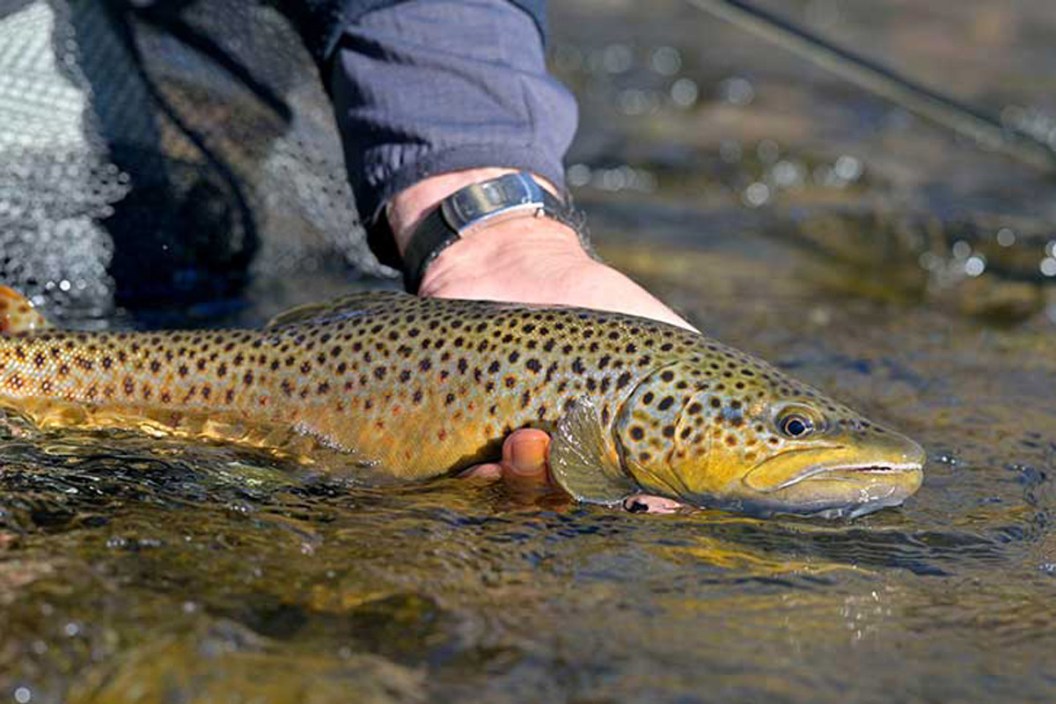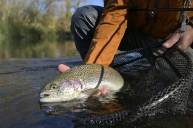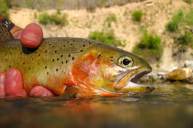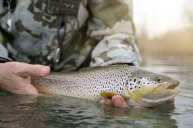Here are six brown trout fishing techniques that will undoubtedly put more fish in your creel.
Brown trout anglers know perfectly well that it's all about putting in your time. When water temperatures are right and the fisherman is ready, the venerable Salmo trutta can be one of our favorite foes.
Brown trout are found the world over, but for our purposes we'll stick to those targeted in North American streams, lakes, and rivers. Some of these fish are put-and-take stocked browns that keep alive the hopes and dreams of anglers everywhere, and some of them are as natural as the streams they reside in.
Whether you are fly fishing a streamer, casting a spinner upstream, or chucking your favorite Rapala stick bait off of the pier there is a big brown trout lurking somewhere. Like a leopard waiting to pounce, these fish can and will tear up your tackle and leave you speechless.
Waiting for the right time of year can almost be a moot point as this trout species is almost always active, even when ice fishing in the winter.
Short of going to your local fish hatchery and drooling over the "breeders" slowly swimming through the spillway, you will need a few extra pointers and we've got them right here.
Regardless of how you where you're fishing for brown trout or how you plan to fish for them, many finesse angling tactics seem to come and go, but the fundamentals have remained true for generations. Not only will this article break down those fundamentals, but it'll also offer different pointers for different types of fisheries.
When it comes to brown trout and fishing tips to catch them, everything matters—from the temperature, to the nearby baitfish and the lure you choose to cast out there.
1. Find a waterfall or spillway
One of my first and best memories of catching a brown trout comes from southern New York State. Having the opportunity to fish in a pristine, wild, and completely natural trout stream is a freshwater fish bucket list item that we recommend to everyone. This particular stream was replete with and old mill and the small waterfall that it was built next to.
My grandfather set me up right at the waterfall with a fat juicy worm and ordered me to let it swim right where the water was flowing over the edge. Within 60 seconds a fat, 16-inch brownie was trying to make off with my offering and the fight was on.
Since then many brown trout anglers have learned that these ferocious fighters will find their way to the moving water and wait in ambush for anything that appears to wash over the flow. The best baits are live nightcrawlers, minnows, and spawn on a #4 hook or smaller.
Get some weight above your hook, such as a split shot or an egg sinker (depending on the conditions), to keep your bait in the strike zone. Let it move through the water like an easy target.
2. Cast upstream with a spinner
In areas where the trout run upstream in the late winter and early spring, brown trout (that actually spawn in the fall) will follow rainbow trout and steelhead as they make their annual spawning runs. While salmon eggs and other roe are the order of the day, brown trout will just as readily chase down the flash of an in-line spinner, such as the Mepps dressed with a squirrel tail shown here.
It is almost imperative to walk upstream—knowing that the fish face into the current and will be facing away from you—and cast against the flow, bringing back your bait with the current. Subtle bounces off of the bottom help the angler to know that his bait is moving naturally through the water column.
In the early part of the year, tip your spinner with a spawn sac. As it bounces off of the bottom, it will release scent and sometimes eggs into the stream as an added enticement. Blue Fox and Panther Martin are good choices as well.
3. Fish the floating eggs
Egg sacs, single eggs, and even egg imitations will catch the brown and rainbow trout most anglers fish for in an early season situation. Good quality fly fishing gear is the order of the day since some females can reach up into the 20-pound range!
Here is where your fishing patience will be tested. It is necessary to stick to a spot, especially in a public fishing area, and continually flip your offering back up and into the current and letting it naturally drift back towards you.
While many stream and river fishermen feel that salmon eggs are the best bet, and rightly so, many others take what eggs they can from the actual browns and rainbows that they do catch and use those. One veteran angler sold me years ago on using sucker spawn, since they are readily a by-catch during this time, and he had the pictures to prove it!
4. Cast stickbaits from the pier
During the spring in areas like the Great Lakes and their tributaries, many anglers will simply find their favorite State Park or other area that has a pier and cast until their arms fall off. Why? The simple reason is that we have success doing so.
For many years, most of these fishermen threw, and still throw, spoons because they cast further, stay in the water longer, and they catch fish. I read an article many years ago with the statement, "stickbait fishermen will out-fish spoon fishermen two to one." Then I set out to prove it to myself.
While you will get an argument from the spoon-chucking crowd, you will almost always find this to be true. Here is where a spool full of good quality 8- to 10-pound test braid or monofilament line will make all of the difference. While mono disappears in the water like no other line, the drawback is that even the slightest nick can cause a break-off. When it comes to braid, one thing's for sure: it sticks out.
I use braided line and a blue fabric marker to color the first 18-24 inches of the line to help it disappear. Since an angler has a serious possibility of hooking a monster brown, he or she had better have at least 150 yards of line on their spool to fish this technique. Go-to baits include Rapala, Rebel, Bomber, or any other shallow running stickbaits in an orange-foil pattern.
5. Troll and roll
Here is where a good quality guide can and will put you on some of the biggest, hardest fighting fish you will ever battle. If there is anything better than setting out multiple rods, placing them in the rod holders, and trying to relax while waiting for strikes, then someone should let us know.
For those of us fortunate enough to have a boat, we try to place as many lines in the water as possible (check your local regulations as some areas have limits) and as far back from the boat as is reasonable. Some use planer boards to take the lines away from the boat, and even include down riggers.
Having good quality electronics helps to find the depth at which fish are using consistently, while also determining what food source is being devoured the most frequently.
Many guides will have one rig with a flasher and spoon combo right next to a jointed Rapala on flat lines, while keeping a downrigger on each side of the boat going at another depth. Speed can be extremely important in the early year; too fast and fish will ignore it, too slow and it won't look natural enough.
6. Catch a trout on the fly
For many trout fishermen, fly fishing is not one way to fish for brown trout, it is the only way. Stalking up on a natural stream in the spring or summer means the epitome of stealth and reliance on one's own ability to fool fish before they ever wet a line.
Once in position, anglers may still have the need to keep a low profile, all while feeling the urgency to cast knowing that a fish is nearby plucking a fresh hatch from the surface. This is where fishing is at its utmost elegance and the main reason why there are so many volumes written on the subject.
Fly rods vary in weight from zero all the way up to a 12-weight or more, with the weight usually translating to the stiffness of the rod. A good all around size to buy for an average trout fisherman would be a 5-weight in a 9-foot length, but to each their own.
An average line would be a 4- to 6-weight depending on the size of the fish and whether the angler is presenting to rising fish with dry flies, such as a mayfly hatch, or possibly presenting a crawfish imitation from below.
Wherever the brown trout lives we want to catch them, big or small. They are available to anglers from the shore or from a boat, and from a stream to the spillway of a large dam. They range in size from the six-inch beauties of the natural stream, to the 30-pound trophy brown trout of the larger lakes and rivers, but they are always bigger in our dreams.
How many of these brown trout techniques have you mastered?
Looking for a little more? Follow my webpage, or on Facebook and Twitter.
NEXT: 10 FLIES FOR TROUT WORTH TRYING OUT




